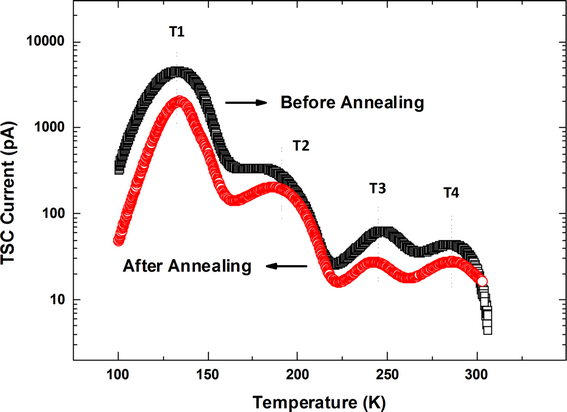Published online by Cambridge University Press: 16 October 2020

We investigated high-resistivity cadmium zinc telluride (CdZnTe):In single crystals annealed in hydrogen to reveal the passivation effect of defects. An overall reduction in the concentration of defect levels induced by annealing was obviously observed by thermally stimulated current measurements. There is a large decrease by 56.51% in the concentration of secondly ionized Cd vacancies (T3) after hydrogenation. The concentration of firstly ionized Cd vacancies (T2) was a little bit lower (17.99%) in the hydrogenated CZT crystals. The formation of neutral InH complex and lower occupation of VCd by In dopant would result in a significant decrease (68.31%) in the trap density of  ${\rm In}_{\rm Cd}^ +$ related shallow donor (T1) after hydrogenation. The bulk resistivity was calculated from I–V characteristic curves to be ~1.97 × 1010 Ωcm before annealing and ~1.78 × 1010 Ωcm after annealing. Hall measurements also reveal n-type conduction for the hydrogenated crystals. Electron mobility was fitted to be about 110 cm2/Vs before annealing and 488 cm2/Vs after annealing, demonstrating better carrier transport properties. Electron mobility-lifetime product could be fitted to be about 3.60 × 10−4 cm2/V before annealing and 5.45 × 10−4 cm2/V after annealing, demonstrating better detector performances.
${\rm In}_{\rm Cd}^ +$ related shallow donor (T1) after hydrogenation. The bulk resistivity was calculated from I–V characteristic curves to be ~1.97 × 1010 Ωcm before annealing and ~1.78 × 1010 Ωcm after annealing. Hall measurements also reveal n-type conduction for the hydrogenated crystals. Electron mobility was fitted to be about 110 cm2/Vs before annealing and 488 cm2/Vs after annealing, demonstrating better carrier transport properties. Electron mobility-lifetime product could be fitted to be about 3.60 × 10−4 cm2/V before annealing and 5.45 × 10−4 cm2/V after annealing, demonstrating better detector performances.